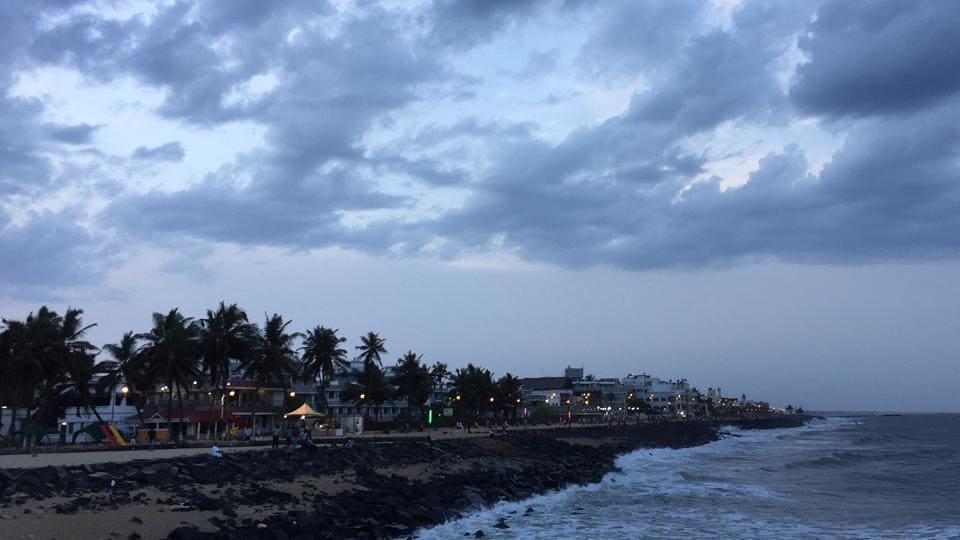It had rained the previous night. It was 9:30 am. The bus that would take us to Puducherry was about to leave in an hour. We were in 10 kilometres away, navigating through narrow lanes, in an alien city, driven by a man who couldn’t understand us, and who seemed to be harbouring a personal grudge against Google Maps.
After ignoring the robot lady’s soothing tones for the tenth time, and swerving into yet another muddy lane, he dropped us at what seemed like the outskirts.
This was Koyambedu Bus Stand in Chennai, a terminal for private buses. It is located around 10 kilometres away from the City Centre, which faces the Marina Beach. There, we were to board the bus to Puducherry, which, we were assured, was less than 3 hours away.

June, as we would soon learn, is the best time to visit Puducherry. The early monsoon showers are infrequent enough to not wash out entire days. They temper the heat, which would have been unbearable even a few weeks ago. The summer holidays are over, which means, thankfully, no bickering families, fewer tourists, and most importantly for us: Cheaper accommodation. If you ever plan a trip there, this is the window you should keep in mind.
There are hourly buses from Chennai to Puducherry. State operated ones can be boarded from a different, government-operated terminal, a short 5-minute walk from Koyambedu. Our tickets, booked on RedBus, cost about Rs 260 one-way.
We’d chosen the non-AC bus, not because of the cost – the air-conditioned ones are just a hundred rupees extra – but because the AC buses seemed to operate only in the afternoon and evening. We wanted to get there early and make the most of our time, so we chose the 10:30 am, scheduled to arrive at 2 pm.

The journey, despite the grating Tamil movie they switched on once we’d hit the highway, was delightful. We’d luckedout with the weather. It was overcast and not too hot. And we’d taken the scenic route – literally – that’s what it was called. With the coastline on our left, and the cool sea breeze wafting in through the windows, we arrived at 2:30 pm, with a scheduled 30-minute break along the way for the locals to grab lunch.
We hopped off at the New Bus Stand, 2 kilometres away from French quarter area of Puducherry, White Town, which was where our hotel was. Spotting what they thought to be clueless travellers, the local auto drivers demanded we pay Rs 150 for the ride. A word of advice here: Your greatest enemy in situations such as this is to appear clueless. So don’t. We pulled out Google Maps, informed the driver that he was lying about the distance, and feeling great pride, got him down to Rs 50 – which is still exorbitant, but you can’t win them all.
The first, most striking sight, especially for someone who had never really seen the seaside before, was the endlessness. Without much warning, as we were riding into the beautiful French quarter, the sky appeared at the horizon, jostling its way through the trees and buildings, and then came the sea. It seemed infinite.

We would take endless walks along the Promenade in the next few days. But the first time was special. Everything you’ve seen, or heard, or read about Puducherry, is true. All of it. The good, and the bad, the mystery, and the exoticism. It’s as pretty as a picture. The lanes are immaculate, lined with trees, old villas on either side, the smell of freshly-baked bread hovering in the air (I am not exaggerating about the bread bit). They still have the old French names.
The Promenade, which is a stretch of road along the Bay of Bengal, is called Goubert Avenue, named after the first CM of Puducherry, Eduard Goubert. Every evening after 6 pm, the Promenade is closed down for traffic, and opened for pedestrians. And every evening, it seems as if the entire town shows up to walk across the rocky beach. The are ladies with gajras in their hair, walking in groups; men, dressed for the occasion in athletic clothes, striding across powerfully, some with their lucky dogs; and the thinkers, staring at the sea for hours, with their backs to the rest of the world, perhaps sipping a coffee at Le Café.
Housed in an old building with a small veranda, and arched corridors, it offers mediocre food at a reasonable price, but in the evenings, the ambiance is priceless.

There is, however, no shortage of far superior food in Puducherry. For breakfast, we returned to the same café every morning. It’s the Café des Arts, on Rue Suffren. It’s a delightful little place, spread across a courtyard, a veranda, and indoor rooms – like most Puducherry restaurants, the Café des Arts probably used to be someone’s home. Now, it sells terrific crepes, croques, and coffee.
For dinner, having been taken slightly aback with how great Villa Shanti was one evening, we returned for a second go-around on our last night. A meal for one at a place like this in Delhi, we couldn’t help but speculate, would probably have set us back a couple of thousand. Here, terribly fancy food, served in fine dining atmosphere, in the most beautiful courtyard, cost approximately 5-700 per person.
A short walk away from Villa Shanti – and, let’s be clear, the biggest benefit of staying in White Town is that most places are a short walk away – is the centuries-old Immaculate Conception Cathedral. Along with the Sacred Heart Basilica, and the Church of Our Lady of Angels, with which it forms a trinity, the town is scattered with these majestic places of worship.

But all of this – the cafes, the Promenade, the pretty avenues, and the churches – is in White Town, which can be explored, in its entirety, on a good day. Hungry for more adventure, and excited to step outside the fenced-off beauty of the French quarter, we hired bicycles and rode 6 kms down the highway to Serenity Beach, only to discover that our good luck had run out. For days, we’d been patting ourselves on our backs for choosing to visit when we did. But Serenity Beach, perhaps wisely, considering its distance from the town (and general lack of appeal), was a ghost town.
The beach was a parking lot of sorts for fishing boats, and only one restaurant (because it was also a bar) was open. Without a single customer in sight, and only two over-eager attendants present (they’d been eying us hopefully from the moment we’d arrived), we caught our breath, waddled about in the water, and rode back.

There is, however, a natural antidote to Serenity Beach. Almost as if it had sensed our disappointment, the town offered a suggestion: Paradise Beach. It would take longer to get there – it’s a 10 km ride from White Town to Chunnumbar Boat House, from where a Rs 250 ticket can be purchased for a 20-minute ferry – but energized with optimism, and desperately wanting to experience a real beach for the first time, we spent the extra cash.
It was the best decision we made. Words cannot describe the magnificence of Paradise Beach, however hard I try. Calling it paradise would be lazy, but it was named that for a reason. And since I can spot a lost cause when I see it, here is a picture instead. This is what’s in store for you. This is what you’re missing right now.


















